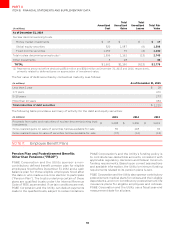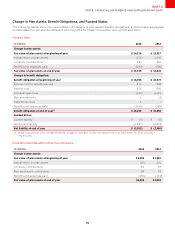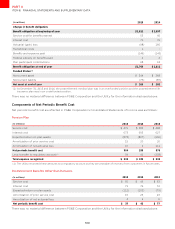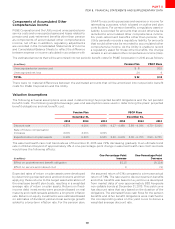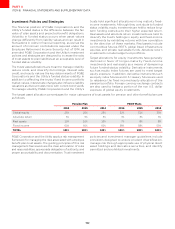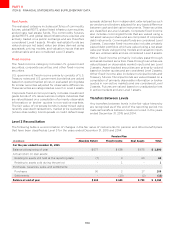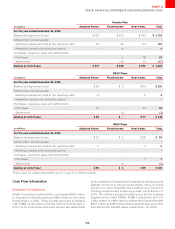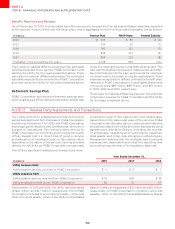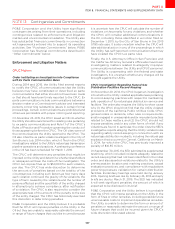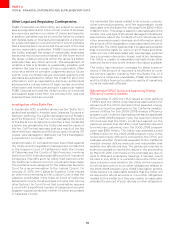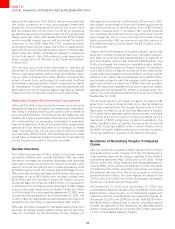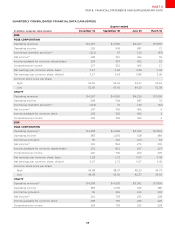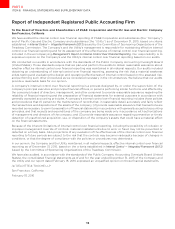PG&E 2015 Annual Report Download - page 116
Download and view the complete annual report
Please find page 116 of the 2015 PG&E annual report below. You can navigate through the pages in the report by either clicking on the pages listed below, or by using the keyword search tool below to find specific information within the annual report.
108
PART II
ITEM 8.FINANCIAL STATEMENTS AND SUPPLEMENTARY DATA
Natural Gas Transmission Pipeline Rights-of-Way
In 2012, the Utility notified the CPUC and the SED that
the Utility planned to complete a system-wide survey of
its transmission pipelines in an eort to address a self-
reported violation whereby the Utility did not properly
identify encroachments (such as building structures
and vegetation overgrowth) on the Utility’s pipeline
rights-of-way. The Utility also submitted a proposed
compliance plan that set forth the scope and timing of
remedial work to remove identified encroachments over
a multi-year period and to pay penalties if the proposed
milestones were not met. In March 2014, the Utility informed
the SED that the survey has been completed and that
remediation work, including removal of the encroachments,
is expected to continue for several years. The SED has
not addressed the Utility’s proposed compliance plan,
and it is reasonably possible that the SED will impose
fines on the Utility or take other enforcement action in
the future based on the Utility’s failure to continuously
survey its system and remove encroachments. The Utility
is unable to reasonably estimate the amount or range of
future charges that could be incurred given the SED’s
wide discretion and the number of factors that can be
considered in determining penalties.
Potential Safety Citations
The SED periodically audits utility operating practices
and conducts investigations of potential violations of laws
and regulations applicable to the safety of the California
utilities’ electric and natural gas facilities and operations.
In addition, the California utilities are required to inform
the SED of self-identified or self-corrected violations.
The CPUC has delegated authority to the SED to issue
citations and impose fines for violations identified through
audits, investigations, or self-reports. The SED can consider
the discretionary factors discussed above (see “Order
Instituting an Investigation into Compliance with Ex
parte Communication Rules” above) in determining the
number of violations and whether to impose daily fines
for continuing violations. The SED is required, however,
to impose the maximum statutory penalty of $50,000
for each separate violation.
The SED has imposed fines on the Utility ranging from
$50,000 to $16.8 million for violations of electric and
natural gas laws and regulations. The Utility believes it
is probable that the SED will impose fines or take other
enforcement action based on some of the Utility’s self-
reported non-compliance with laws and regulations
or based on allegations of non-compliance with such
laws and regulations that are contained in some of the
SED’s audits. The Utility is unable to reasonably estimate
the amount or range of future charges that could be
incurred for fines imposed by the SED with respect to
these matters given the wide discretion the SED has in
determining whether to bring enforcement action and the
number of factors that can be considered in determining
the amount of fines.
Federal Matters
Federal Criminal Indictment
On July 29, 2014, a federal grand jury for the Northern
District of California returned a 28-count superseding
criminal indictment against the Utility in federal district court
that superseded the original indictment that was returned
on April 1, 2014. The superseding indictment charges 27
felony counts alleging that the Utility knowingly and willfully
violated minimum safety standards under the Natural Gas
Pipeline Safety Act relating to record-keeping, pipeline
integrity management, and identification of pipeline threats.
The superseding indictment also includes one felony count
charging that the Utility illegally obstructed the NTSB’s
investigation into the cause of the San Bruno accident. On
December 23, 2015, the court presiding over the federal
criminal proceeding dismissed 15 of the Pipeline Safety
Act counts, leaving 13 remaining counts. The maximum
statutory fine for each felony count is $500,000, for total
potential fines of $6.5 million. On December 8, 2015, the
court also issued an order granting, in part, the Utility’s
request to dismiss the government’s allegations seeking
an alternative fine under the Alternative Fines Act. The
Alternative Fines Act states, in part: “If any person derives
pecuniary gain from the oense, or if the oense results in
pecuniary loss to a person other than the defendant, the
defendant may be fined not more than the greater of twice
the gross gain or twice the gross loss.” The court dismissed
the government’s allegations regarding the amount of
losses, but concluded that it required additional information
about how the government would prove its allegations
about the amount of gross gains prior to deciding whether
to dismiss those allegations. (Based on the superseding
indictment’s allegation that the Utility derived gross gains
of approximately $281 million, the potential maximum
alternative fine would be approximately $562 million.)
After considering the additional information submitted by
the government, on February 2, 2016, the court issued an
order holding that if the government’s allegations about the
Utility’s gross gains are considered, they would be considered
in a second trial phase that would take place after the trial
on the criminal charges. The trial on the criminal charges
currently is scheduled to begin March 22, 2016.
The Utility entered a plea of not guilty. The Utility believes
that criminal charges and the alternative fine allegations
are not merited and that it did not knowingly and willfully
violate minimum safety standards under the Natural Gas
Pipeline Safety Act or obstruct the NTSB’s investigation, as
alleged in the superseding indictment. PG&E Corporation
and the Utility have not accrued any charges for criminal
fines in their Consolidated Financial Statements as such
amounts are not considered to be probable.
Other Federal Matters
The Utility was informed that the U.S. Attorney’s Oce was
investigating a natural gas explosion that occurred in Carmel,
California on March 3, 2014. The U.S. Attorney’s Oce in San
Francisco also continues to investigate matters relating to
the indicted case discussed above. It is uncertain whether
any additional charges will be brought against the Utility.


